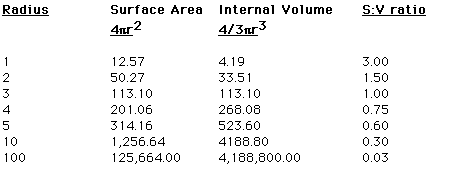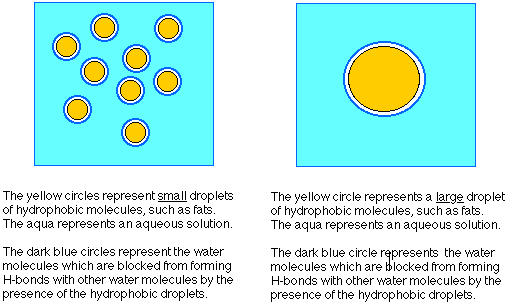Chemistry Review
Hydrophobic Interactions
Nonpolar molecules cannot form H-bonds with
H2O, and are therefore insoluble in H2O.
These molecules are known as hydrophobic (water hating),
as opposed to water loving hydrophilic molecules
which can form H-bonds with H2O. Hydrophobic molecules tend
to aggregate together in avoidance of H2O molecules; hydrophobic
interactions are clearly demonstrated with Vinegar and Oil Salad Dressing.
The oil floats on the vinegar (an aqueous solution). The oil can
be broken up into small droplets suspended in the vinegar, but they always
fuse together to form larger and larger droplets until there are two layers
again. This attraction/repulsion is known as the hydrophobic (fear
of water) force.
Surface : Volume Ratios
One of the most important mathematical concepts in Biology is the relationship
between Surface Area and Internal Volume. Briefly
stated this relationship says that for any 3-dimensional form, the
ratio of Surface Area to Internal volume is NOT constant
- it is inversely related to size. In
other words, as size gets larger, the Surface Area becomes smaller
relative to the Internal Volume.
In this numerical example a sphere is used, but the concept is the same
for any 3 dimensional object.

| ASIDE: One of the best
examples of how this mathematics applies to Biology is in Ecology.
Bergmann's Rule and Allen's rule were first discovered by
Ecologists, but their explanation is pure Geometry!!
See Dr. Lott for an explanation and Dr. Dalby for actual
examples! |
ASIDE: Another
excellent example of how this mathematics applies to Biology is the question
of cell size - why are cells so small? Why is it impossible
to have a giant amoeba which eats Manhattan? See
Dr. Smith or Dr. Eggleton for an explanation! |
Insolubility of Hydrophilic and Hydrophobic Molecules
Suppose we consider the 9 small droplets of
hydrophobic molecules - is there a difference in their surface areas
if they are separated as 9 small droplets, or if they all fuse into a single
large one? YES!

A single large droplet would have the same
internal volume as 9 small ones, but considerably less surface
area than the total surface area of the nine small ones.
The amount of oil (volume) is the same whether it is
dispersed in the 9 smaller droplets or a single large droplet. However
the single large droplet has far less surface area exposed
to the water molecules.
Decrease in Surface Area
452.4 - 217.5 = 234.92 mm2 less
surface area with a single large droplet instead of 9 small ones.
Per cent Decrease in Surface Area
234.92 / 452.4 = 51.9%. The decrease
in surface area is 51.9% of the total for the 9 small droplets.
This means
that 51.9% more water molecules can H-bond with each other if the hydrophobic
molecules are present in a single large droplet rather than 9 smaller
ones.
Therefore the
situation is this:
-
lowest energy state
is when the number of H bonds is maximized.
-
decreasing surface
area presented by hydrophobic molecules increases number of H-bonds which
can be formed.
-
surface area presented
by hydrophobic molecules decreases as the size of the droplets increases.
-
Therefore attractions
of the water molecules for each other will tend to "squeeze"
the fat droplets together into larger (and fewer) droplets.
The end result
is that the hydrophobic and hydrophilic molecules separate from each other
completely (like the layers in vinegar/oil salad dressing)! They
are INSOLUBLE in each other.